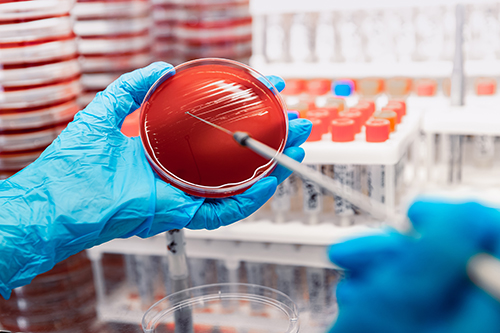
Microbial culture is traditionally the gold standard for the detection of many infectious pathogens. [1] [2] [3] However, limitations such as long turnaround times, intensive labor, and failure to identify difficult-to-culture microorganisms have prompted laboratorians and clinicians to consider alternatives. Molecular diagnostics (MDx) technologies, such as nucleic acid amplification tests (NAATs), are faster, more sensitive, more specific, and can detect organisms missed by routine culture.
These advantages are acknowledged by infectious disease experts who have included more NAAT-based diagnostics in their recommendations. A 2018 guideline by the Infectious Diseases Society of America (IDSA) and the American Society for Microbiology states that “NAATs have largely replaced rapid antigen tests and culture for respiratory virus detection.” [4] Indeed, MDx have played a pivotal role throughout the coronavirus crisis and in the outbreaks of monkeypox. Laboratory-based NAATs “are considered the most sensitive tests for detecting SARS-CoV-2,” notes the US Centers for Disease Control and Prevention (CDC). [5] According to the World Health Organization (WHO), confirmation of monkeypox infection relies on NAAT, using real-time or conventional polymerase chain reaction (PCR) to detect unique sequences of viral DNA. [6]
Benefits of Molecular Diagnostics

Apart from being quicker and more accurate than microbial culture, MDx have made the next generation of testing possible: a multiplex molecular panel yielding results for a breadth of potential pathogens in a single test from a single specimen. When the dominant symptom is diarrhea, for example, clinicians can order various individual tests, including a set of pathogen-specific cultures, yet the causative agents often remain unknown even after repeated testing. This makes diagnosis difficult and treatment nonspecific. Similar situations can occur when a clinician tries to delineate flu-like symptoms in an upper respiratory tract infection, a burning sensation in a urinary tract infection, a vaginal discharge, or a fever of unknown origin. In recent years, various multiplex molecular panel tests for gastrointestinal, respiratory, urinary, sexually transmitted, and other infections have become available. With faster and more accurate diagnosis, these panel tests allow earlier and more specific treatments. Such streamlined approach could potentially lead to better clinical outcomes and less inappropriate antibiotic usage.
Gastrointestinal System
Campylobacter is the most common cause of human gastroenteritis worldwide and can be fatal among children, elderly, and immunosuppressed individuals.[7] However, it is often overlooked due to difficulties in culture diagnosis. Campylobacter species are fastidious, growing only in microaerobic environments. Campylobacter culture requires stool sample implantation into a selective medium and incubation at 42 °C for about 72 hours. Once cultured, bacteria can take an additional 7 days to be identified. In a study comparing the performance of culture and culture-independent tests for the diagnosis of Campylobacter enteritis, molecular tests were found to be superior in terms of sensitivity, specificity, and positive predictive value. Among the 400 specimens, 41 were evaluated as Campylobacter positive by PCR. Out of those Campylobacter-positive specimens, only 21 were culture-positive (sensitivity: 51.2%). [8]
A similar pattern was observed in the Global Enteric Multicenter Study (GEMS), which investigated 32 entero-pathogens in stool samples by quantitative real-time PCR (qPCR) and traditional microbiological methods. The pathogen-specific attributable incidences of Campylobacter with qPCR were twice that of the original microbiological methods. qPCR-derived attributable incidence surpassed traditional methods for other gastrointestinal pathogens including adenovirus (around five times), Shigella spp / Enteroinvasive Escherichia coli (EIEC) (around two times), and heat-stable enterotoxin-producing Escherichia coli (around 1·5 times). [9]
The CDC confirms a marked increase in the use of culture-independent diagnostic tests (CIDTs) for detecting Campylobacter, Salmonella, Shigella, and other gastrointestinal pathogens over the last decade. [10] [11] [12] [13] A CDC report on incidences and trends of foodborne pathogens noted a change in the testing behavior: healthcare providers “might be more likely to order CIDTs because these tests are quicker and easier to use than traditional culture methods.” The report further noted an uptick in the adoption of DNA-based syndromic panels by clinical laboratories. [10]
Respiratory System
Multiplex molecular panels have proved particularly useful in detecting the causative agents in atypical pneumonia. Historically, “atypical” pneumonias were characterized by slightly different symptoms, appearing differently on chest X-rays, and responding poorly to standard antibiotics. Nowadays, pneumonias are considered “atypical” if they are difficult to detect through standard bacterial methods such as culture. [14] In a study on patients with symptoms of atypical pneumonia who tested negative for typical agents of pneumonia by culture and viral PCR, researchers used multiplex RT-PCR to detect key bacterial pathogens causing atypical pneumonia. Among all 368 samples deemed culture- and viral PCR-negative, 7 samples tested positive for Bordetella parapertussis, 170 for Bordetella pertussis, 3 for Chlamydia pneumoniae, 11 for Chlamydia psittaci, 20 for Legionella pneumophila, 11 for Legionella spp. and 146 for Mycoplasma pneumoniae. Moreover, in two patients a co-infection of Bordetella pertussis and Bordetella parapertussis was observed. [15] By accurately identifying causative pathogens, MDx may improve diagnosis and subsequent patient management.
Urinary System
Culture and MDx differ in their ability to detect co-infection or polymicrobial infection. In a study that evaluated 582 patients with lower urinary tract infections, PCR was found to be significantly more sensitive than urine culture for detecting polymicrobial infections. Among the 175 patients with polymicrobial infections, PCR reported 95% and culture only reported 22% of cases. In addition, PCR revealed polymicrobial infections in 67 patients with negative culture results.[16] Simultaneous detection of various pathogens could aid clinical management, allowing more specific treatments and fewer recurrent infections resulting from inadequate or inappropriate treatments. Furthermore, multiplex PCR coupled with pooled antibiotic sensitivity can offer clinically relevant microbiological data missed by standard urine culture alone. [17]
Sexually Transmitted Diseases and Other Infections
For certain sexually transmitted diseases, such as Chlamydia trachomatis and Neisseria gonorrhoeae, the CDC highlights NAATs as the preferred diagnostic approach [15]. The IDSA is in full support, noting “NAATs are the preferred assays for detection because of increased sensitivity while retaining specificity in low-prevalence populations (pregnant patients) and the ability to screen with a noninvasive urine specimen.” [4].
The ability to offer quick and accurate results without requiring access to laboratories that can grow cultures has prompted the WHO to include more MDx in their recommendations. For example, the third WHO Model List of Essential In Vitro Diagnostics includes PCR for the fungus Pneumocystis jirovecii, which causes Pneumocystis pneumonia, and a human measles reverse transcription-PCR (RT-PCR) test, which can accurately confirm cases and help prevent outbreaks [19].
In addition to pathogen detection, MDx can monitor viral load over time to determine effectiveness of antiviral therapy against HIV and Hepatitis viruses. For example, the WHO lists “qualitative or quantitative HCV virological nucleic acid” tests as essential in vitro diagnostics for diagnosing viremic HCV, monitoring treatment response, and as a “test of cure.” [20]
Benefits of Culture
Microbial culture is the benchmark for diagnosing many infectious diseases, particularly in areas where MDx are immature, expensive, require laboratorians with skilled molecular techniques, and produce positive results that may be clinically insignificant.
Culture is crucial for determining antimicrobial susceptibility, such as among patients with Mycobacterium tuberculosis infections and pregnant women with penicillin allergy having a Group B Streptococcus colonization.[21] [22]. Besides antimicrobial susceptibility data, culture may also be needed for molecular subtyping. Such information is important in identifying antibiotic resistance, tracking outbreaks, and monitoring disease trends.[13]
For public health surveillance, the CDC encourages laboratories to use reflex culture - culturing specimens with positive CIDT results - for bacteria of public health importance, such as Campylobacter, Salmonella, Shigella, Shiga toxin-producing Escherichia coli, Vibrio, and Yersinia infections. [10] [11] [12] [13]
Looking Ahead
The decision to supplement or even substitute culture with MDx for infectious diseases depends on several factors: MDx performance, regulatory approvals, reimbursement, availability and proximity of testing facilities, and awareness of MDx among clinicians and patients.
While it may take years for more MDx to be included in the official clinical management guidelines, the ongoing pandemic of coronavirus and the outbreaks of monkeypox have highlighted the importance of MDx. Laboratories newly equipped with MDx infrastructure from recent events may therefore be in an advantageous position to expand testing menus to include infectious diseases beyond SARS-CoV-2.
To Learn More:
Educational Resources for Laboratories Implementing Molecular Diagnostic Tests
Clinical Value of Molecular Testing
Respiratory Tract Infections Learning Guide (Create an account for free access)
References
- Padmanaban V, Ranganathan UDK. CRISPR-Cas system and its use in the diagnosis of infectious diseases. Microbiol Res. 2022 Jun 30;263:127100. doi: 10.1016/j.micres.2022.127100. Epub ahead of print. PMID: 35849921. https://pubmed.ncbi.nlm.nih.gov/35849921/
- Limmathurotsakul D, Jamsen K, Arayawichanont A, et al. Defining the true sensitivity of culture for the diagnosis of melioidosis using Bayesian latent class models. PLoS One. 2010 Aug 30;5(8):e12485. doi: 10.1371/journal.pone.0012485. PMID: 20830194; PMCID: PMC2932979. https://pubmed.ncbi.nlm.nih.gov/20830194/
- Suárez I, Fünger SM, Kröger S, et al. The Diagnosis and Treatment of Tuberculosis. Dtsch Arztebl Int. 2019 Oct 25;116(43):729-735. doi: 10.3238/arztebl.2019.0729. PMID: 31755407. https://pubmed.ncbi.nlm.nih.gov/31755407/
- Miller JM, Binnicker MJ, Campbell S, et al. A Guide to Utilization of the Microbiology Laboratory for Diagnosis of Infectious Diseases: 2018 Update by the Infectious Diseases Society of America and the American Society for Microbiology. Clin Infect Dis. 2018 Aug 31;67(6):e1-e94. doi: 10.1093/cid/ciy381. PMID: 29955859; PMCID: PMC7108105. https://pubmed.ncbi.nlm.nih.gov/29955859/
- COVID-19: Nucleic Acid Amplification Tests (NAATs) https://www.cdc.gov/coronavirus/2019-ncov/lab/naats.html
- Laboratory Testing for the Monkeypox Virus: Interim Guidance https://www.who.int/publications/i/item/WHO-MPX-laboratory-2022.1
- Campylobacter: Key Facts
https://www.who.int/news-room/fact-sheets/detail/campylobacter
- Özcan N, Bacalan F, Çakır F, Bilden A, Genişel N, Dal T. Culture and culture-independent diagnostic tests in Campylobacter enteritis. J Infect Dev Ctries. 2022 Apr 30;16(4):616-621. doi: 10.3855/jidc.14902. PMID: 35544622. https://pubmed.ncbi.nlm.nih.gov/35544622/
- Liu J, Platts-Mills JA, Juma J, et al. Use of quantitative molecular diagnostic methods to identify causes of diarrhoea in children: a reanalysis of the GEMS case-control study. Lancet. 2016 Sep 24;388(10051):1291-301. doi: 10.1016/S0140-6736(16)31529-X. PMID: 27673470; PMCID: PMC5471845. https://www.ncbi.nlm.nih.gov/pmc/articles/PMC5471845/
- Marder EP, Cieslak PR, Cronquist AB, et al. Incidence and Trends of Infections with Pathogens Transmitted Commonly Through Food and the Effect of Increasing Use of Culture-Independent Diagnostic Tests on Surveillance — Foodborne Diseases Active Surveillance Network, 10 U.S. Sites, 2013–2016. MMWR Morb Mortal Wkly Rep 2017;66:397–403. DOI: http://dx.doi.org/10.15585/mmwr.mm6615a1 https://www.cdc.gov/mmwr/volumes/66/wr/mm6615a1.htm
- Campylobacter (Campylobacteriosis): Information for Health Professionals https://www.cdc.gov/campylobacter/technical.html
- Salmonella: Diagnostic and Public Health Testing https://www.cdc.gov/salmonella/general/diagnosis-treatment.html
- Foodborne Illness and Culture-Independent Diagnostic Tests (CIDTs) https://www.cdc.gov/foodnet/reports/cidt-questions-and-answers-2015.html
- Atypical Pneumonia https://www.cdc.gov/pneumonia/atypical/index.html
- Wagner K, Springer B, Imkamp F, et al. Detection of respiratory bacterial pathogens causing atypical pneumonia by multiplex Lightmix® RT-PCR. Int J Med Microbiol. 2018 Apr;308(3):317-323. doi: 10.1016/j.ijmm.2018.01.010. Epub 2018 Jan 31. PMID: 29397298. https://pubmed.ncbi.nlm.nih.gov/29397298/
- Wojno KJ, Baunoch D, Luke N, et al. Multiplex PCR Based Urinary Tract Infection (UTI) Analysis Compared to Traditional Urine Culture in Identifying Significant Pathogens in Symptomatic Patients. Urology. 2020 Feb;136:119-126. doi: 10.1016/j.urology.2019.10.018. Epub 2019 Nov 9. PMID: 31715272. https://pubmed.ncbi.nlm.nih.gov/31715272/
- Luke, D. Baunoch. Baunoch. After 180 Years, Is It Time for Something Better for Diagnosing UTI’s? . JOJ Urology & Nephrology, 2020; 7(2): 555714. DOI: 10.19080/JOJUN.2020.07.555714 https://juniperpublishers.com/jojun/JOJUN.MS.ID.555714.php
- Centers for Disease Control and Prevention. Sexually transmitted disease treatment guidelines. MMWR Morb Mortal Wkly Rep 2015; 64:1–135. https://www.cdc.gov/mmwr/preview/mmwrhtml/rr6403a1.htm
- Report of the Third Meeting of the WHO Strategic Advisory Group of Experts on In Vitro Diagnostics, 2020 (including the Third WHO Model List of Essential In Vitro Diagnostics) https://www.who.int/publications/i/item/9789240019102
- Second WHO Model List of Essential In Vitro Diagnostics https://www.who.int/publications/i/item/WHO-MVP-EMP-2019.05
- Report of an Expert Consultation on the Uses of Nucleic Acid Amplification Tests for the Diagnosis of Tuberculosis https://www.cdc.gov/tb/publications/guidelines/amplification_tests/default.htm
- Shin JH, Pride DT. Comparison of Three Nucleic Acid Amplification Tests and Culture for Detection of Group B Streptococcus from Enrichment Broth. J Clin Microbiol. 2019 May 24;57(6):e01958-18. doi: 10.1128/JCM.01958-18. PMID: 30944190; PMCID: PMC6535594. https://pubmed.ncbi.nlm.nih.gov/30944190/